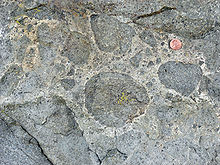- Metaconglomerate
-
Metaconglomerate is a rock type which originated from conglomerate after undergoing metamorphism. Conglomerate is easily identifiable by the pebbles or larger clasts in a matrix of sand, silt, or clay. Metaconglomerate looks similar to conglomerate, although sometimes the clasts are deformed. The cement matrix of conglomerate is not as durable as the grains, and hence when broken, conglomerate breaks around the grains. Metaconglomerate, however, breaks through the grains, as the cement has recrystallized and may be as durable as the clasts.[1]
The metaconglomerates of the Jack Hills of Western Australia are the source rocks for much of the detrital zircons that have been dated to be as old as 4.4 billion years.[2][3]
References
- ^ http://www.gc.maricopa.edu/earthsci/imagearchive/metaconglomerate.htm Metaconglomerate
- ^ VALLEY, John W.1, CAVOSIE, A.J., WILDE, S.A., GRANT, M., and LIU, Dunyi, JACK HILLS METACONGLOMERATE: EVIDENCE OF EARLY AND LATE ARCHEAN HYDROSPHERE, The Geological Society of America, 2002 Denver Annual Meeting http://gsa.confex.com/gsa/2002AM/finalprogram/abstract_39602.htm
- ^ ftp://rock.geosociety.org/pub/reposit/2002/2002034.pdf from: Peck, W.H., Valley, J.W., Wilde, S.A., and Graham, C.M., 2001, Oxygen isotope ratios and rare earth elements in 3.3 to 4.4 ga zircons: Ion microprobe evidence for high δ18O continental crust in the early Archean: Geochimica et Cosmochimica Acta, v. 65, p. 4215-4229.

This article related to petrology is a stub. You can help Wikipedia by expanding it.

